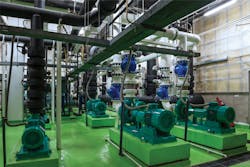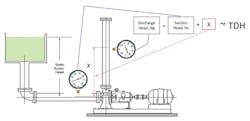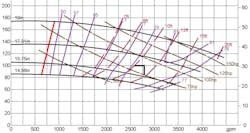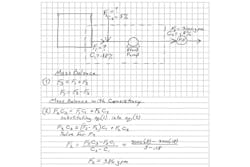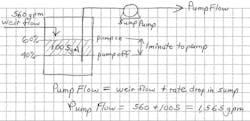One of the first things medical professionals do when seeing patients is to baseline their conditions with some vital sign measurements. This is the foundation for determining whether any other testing is necessary to solve the health problem. The basic vital signs they may check are blood pressure, temperature, pulse and they may even do some bloodwork. The same is true for pumping equipment. It requires gathering enough vital signs to determine the pump operating point, which will reveal many things about pumping system health. The pump operating point will determine things like pump efficiency and pump reliability.
An operating point within +5 percent/-10 percent of the best efficiency point (BEP) is generally a healthy condition. Extreme deviation from BEP in either direction will cause pump reliability to decline. So back to the main subject of this article, which is how does one determine where a pump is operating? If impeller diameter is known, finding either the pump head, flow or power will reveal the operating point. It would be easy to have an accurate reading with a flowmeter in the line or ultrasonic flow measurement. However, this can be tricky in some plant systems where good flow data is not available or reliable. When flow data are not available, operators can use the following five ways to try and determine a pump operating point.
1. Measure total dynamic head
Total dynamic head (TDH) is total head developed across the pump centerline reference for a given set of conditions (pump speed, impeller diameter, etc.). The best-case scenario is to have pressure gauges on the discharge and suction sides of the pump. For most systems, suction-side pressure gauges are unavailable, and the tank head may be used as a close enough estimate of suction head.
Some corrections for adjusting back to pump centerline and any major friction piping losses may need to be considered. Generally the friction losses can be ignored when known pressure is close to the pump. If a pressure transmitter is in the system, corrections for pressure differences may be calculated back to the pump centerline, as shown in Figure 1.After obtaining the pump TDH from these pressures and the correct pump curve, the operating point can easily be determined. When good pressures are obtained, this is likely the most accurate of all methods. This also provides direct data to the pump performance curve, as shown in Figure 2, where 100-foot TDH was determined. This method may be challenging for pump curves that are very flat and for which pressure measurements must be extremely accurate to locate the pump operating point.
Brake horsepower (BHP) can also be calculated once the total dynamic head has been measured. The BHP from the TDH can be used to compare with the BHP calculated from the motor’s electrical energy. This is a good check to make sure both methods appear in line with each other. The BHP can be calculated with the following basic equation.
BHP = H*Q*SG/(3960*η)
Where:
H = pump total dynamic head in feet
Q = pump flow in gallons per minute
SG = specific gravity of fluid being pumped
η = pump efficiency
2. Measure motor/driver load BHP
While direct power measurements may be taken on some drive panels easily, the most common methods involve the measurement of individual parameters such as current and voltage. Measure or obtain the most accurate parameters to calculate and determine the motor load from the basic three-phase power equation, as shown below.
BHP = 1.732(I)V(pf)η
Where:
V = voltage, volts
I = current, amps
Pf = power factor
η = motor efficiency
For a motor, this includes line voltage and amps, not the nameplate voltage or amps. Many motors have "460V" on the motor nameplate, but plant voltage may vary 15 to 20 volts. Measure motor amperage on all three legs of the three-phase motor to make sure they are balanced and to improve the accuracy of this method. Also, use the adjusted power factor and motor efficiency based on the actual motor load conditions instead of the nameplate values. The power factor can be drastically reduced for a lightly loaded motor, so this must be closely evaluated. This parameter alone can introduce large errors to this method.
Motor efficiency can vary slightly by motor loading, but it is relatively small compared to the power factor. Multiple errors in each variable in this method can result in compounding errors when the calculation is made. This method is an indirect method for determining the pump operating point, but it is also useful to verify a pump operating point when combined with other data. Some operators may ratio the motor amps to the nameplate amps and nameplate motor horsepower (hp) to get actual motor hp, but this can be inaccurate because of power factor differences. The power method can also be difficult for high-specific speed pumps because of the curve shape.
3. Process instrumentation and process mass balance calculations
If a flowmeter exists somewhere in the process system, this can easily be used to calculate the operating point. It does not always have to be in the main pump line either. Using simple mass balance calculations may allow backing into the flow for the pump. If the fluid is a suspended solids or slurry, the consistency equation may also be useful. An example of a mass balance on a pulp process system is shown in Figure 3.
The use of clamp-on ultrasonic flowmeters is another way to determine flow conditions. Finding the right location to install a clamp-on flowmeter is essential, but it may be difficult on some piping runs.
4. Tank volume changes
If the system is a batch process, a calculation for system volume change can be completed. It can be tricky if an incoming flow must be accounted for to get the total flow being pumped. Processes in which flows dump into a weir can also be effective in determining an operating point by using a weir formula or table. For tank volume calculations, measuring the time for a fixed volume tank change will yield the pump flow rate. In the case in Figure 4, the sump is started and stopped based on minimum and maximum levels. In this batch operation example, an incoming flow is also figured into the calculation.
5. Other operating data
While these data are supplemental for one of the previous methods and are not conclusive, they can provide valuable information when the accuracy of one of the other methods is questionable. It is always good when all data tell the same story. Some of this other data relate to vibration on the pump. Vibration data can show vane pass frequency, flow turbulence and cavitation. A pump that operates with elevated vane pass frequency is likely not operating near BEP but to the left or right of BEP. Left of BEP may look like the vibration signature in Figure 5, in which the pump runs throttled and exhibits dominant vane pass frequency. A vibration signature with vane pass and a raised floor (flow turbulence or cavitation) is likely a pump operating to the right of BEP. Net positive suction head required (NPSHR) increases greatly at high flows beyond BEP. If throttling this pump reduces the vibration, that will confirm the cavitation condition. If throttling makes the vibration worse, the pump is likely running too far left of BEP.
Maintenance records or inspection of the pump impeller may also reveal clues as to where the pump typically operates. Vane pitting may indicate cavitation issues or seal failures may indicate extreme throttling and shaft deflection.
Fluid temperatures can reveal recirculation and dead head conditions. High pump thrust loads may also result with high bearing temperatures.
Do not to forget that many pumping systems have multiple operating points. There may only be one operating point that is destructive to the pump and one may be difficult to observe. Various forms of continuous condition monitoring such as temperature and vibration or process trending of pressures, flows and motor loads may be required to catch an alternative operating point.
In the real world of industrial process systems, clean sources of good data are seldom available to perform a complete analysis by the book every time. Pump system analysis may involve data collection from all methods to confidently determine the pump operating point, so look for these other modeling methods to help understand pump operation. Like a court case, many times it takes the combined evidence to reveal what is happening in pump systems.
